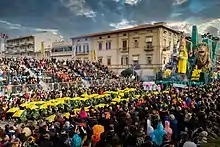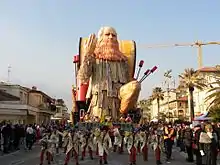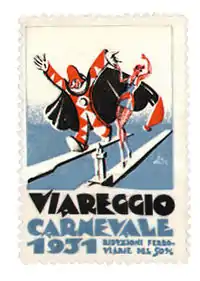Carnival of Viareggio
The Carnival of Viareggio (Italian: Carnevale di Viareggio) is a carnival event annually held in the Tuscan city of Viareggio, in Italy. It is considered amongst the most renowned carnival celebrations in both Italy and Europe.



Overview
Its main characteristic is given by the parade of floats and masks, usually made of paper-pulp, depicting caricatures of popular people, such as politicians, showmen and sportsmen; the parade is held on the Viareggio avenue located alongside the local beach. After almost a century and a half, the Viareggio Carnival carries on its vibrant traditions having become one of Europe’s longest-established festivals and undoubtedly Italy’s best known event. Every year, the Carnevale di Viareggio attracts more than 500.000 spectators who gaily crowd the city’s boardwalk as they admire the breath-taking parades of papier-mâché gargantuan floats.
The first Viareggio carnival parade was held in 1873, when some wealthy middle-class men decided to organize a parade of floats adorned with flowers; a number of local citizens, as a sign of protest, then decided to put on masks in order to show their refusal of high taxes they were forced to pay. The first float to win the parade, in 1883, was named I Quattro Mori (The Four Moors), an accurately representation of the homonymous Livorno statue. The official mascot of the Viareggio carnival is Burlamacco, first depicted in 1931 by Uberto Bonetti. Since 2001, all the floats are built in an apposite seat, called Cittadella del Carnevale (Carnival Citadel), located on the northern side of the Viareggio city territory. Carnival celebrations are scheduled every weekend night in the city's different quarters or Rioni with the best known bars, restaurants, discos and hotels in Versilia hosting all-night colourful masked parties. Additionally, during the four-week celebration, plays in vernacular language are staged around the city. A month-long unique opportunity for the citizens of Viareggio to strengthen their sense of identity and to be reborn under the sign of Burlamacco, the official mask of the Carnevale di Viareggio. What makes the Carnevale di Viareggio one of a kind are its papier-mâché gargantuan allegorical floats with the largest ones towering 70 feet or 20 meters over the crowds and weighing about 40 tons. A stunning parade that is similar to the Ancient Triumphs held in the Renaissance and that highlights the great yacht and sailboat building skills which are still at the heart of Viareggio’s tradition. Veritable moving theatres, these allegorical papier-mâché floats are the product of the unequalled creativity blended with the extraordinary sculpture and painting skills of the city’s magical craftsmen; and represent the highest expression of this popular art, now world renown. The Carnival Giant Float Parades take place along a 2 kilometre ring set aside Viareggio’s Liberty-era boardwalk, best known as La Passeggiata. Spectators can admire the works of art up close becoming themselves a part of the cheerful parade. During this period, Viareggio and it’s Passeggiata become a true open air Museum where people from all over the world come together to celebrate Carnival. Parades also include traditional music bands and performers competing for the prize of most original masks. A fun-filled mix of excitement, culture and tradition in a wide ranging entertainment program for both children and adults. The Tuscan city of Viareggio is also known as the Pearl of the Tyrrhenian Sea for its long sandy beaches, its pinewood groves and beautiful promenade. It is the perfect natural stage for Carnival with the Apuan Alps and Art Deco seaside villas serving as a unique backdrop. A month-long Carnival celebration that attracts thousands of spectators from Viareggio, from Italy and from abroad.
In 1925, for the very first time, local sculptor Antonio d'Arliano employed the paper mould technique on iron and wood scaffolding, thus changing forever the way the structure of Carnival floats would be made. Since then, the use of papier-mâché has become an integral element in the construction of these giant allegorical floats. Today, this knowledge, is handed down from father to son who are in turn happy to share their knowledge with those who wish to hone in their skills in this field.

The Cittadella
The impressive complex of the Cittadella del Carnevale di Viareggio was inaugurated in 2001 and is the largest and most important Italian thematic center dedicated to carnival floats and masks. It houses sixteen large hangars and workshops where the giant floats are built, a laboratory where the art of papier-mâché is taught, three museum areas and a historical photo and film archive and documentation center. At the Citadel of the Carnevale di Viareggio it is possible to visit the Papier Mâché Museum where the breathtaking floats are stored and the Museum of the Carnival that illustrates the over 100-year old history of the Carnevale through original documents, photographs, sketches, posters and models.
External links
![]() Media related to Carnival_of_Viareggio at Wikimedia Commons
Media related to Carnival_of_Viareggio at Wikimedia Commons
- (in Italian and English) Official website
 Carnival of Viareggio, Italy, 2019
Carnival of Viareggio, Italy, 2019 Carnival of Viareggio, Italy, 2019
Carnival of Viareggio, Italy, 2019
